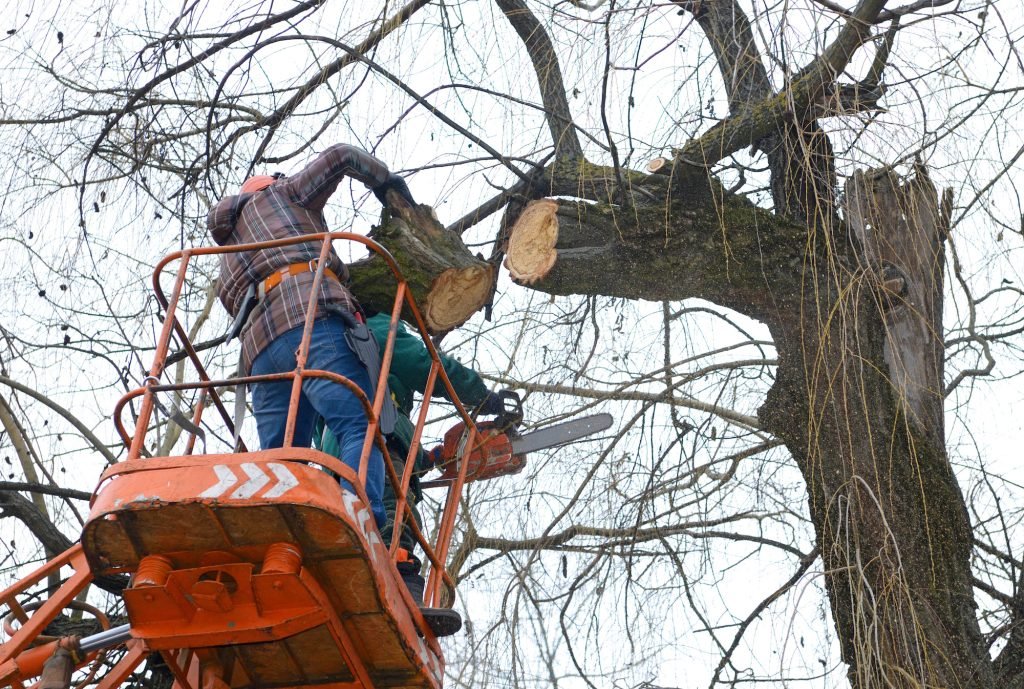
Lawn destroyed after tree removal? Don’t panic. You can always fix it. Tree work—whether it is tree removal, stump grinding, or heavy limb pruning, we all agree it can take a serious toll on your once-lush lawn. You may be left with compacted soil and wood chips everywhere. There could be bare patches as well where grass once grew. But the good news is that amidst all this, recovery is possible. Your lawn can become even greener than before by adopting the right strategy with little time and effort. Follow this to learn how to recover your lawn after major tree work.
1: Clear Out the Debris and Wood Chips
Crew has finished their job? Now, your lawn may be covered in wood chips, twigs, branches, and sawdust. Mulch can also be there. But if in excessive amounts it can block sunlight.
- Grab a rake and clear all the wood debris and dispose of it. You can use it around flower beds and shrubs too.
- Use a leaf blower or a wide-toothed rake to remove finer particles like sawdust.
- If stump grinding was performed, remove or redistribute the grindings.
Bonus tip: Don’t till the grindings into the soil unless you are planting a new bed. Why? They can deplete nitrogen and stunt grass growth.
2: Address Soil Compaction
Heavy machinery like bucket trucks or stump grinders can compact your soil, thereby restricting air and nutrient flow to the grassroots. Before you even think about planting or reseeding, loosen the soil up the soil first.
- For minor compaction, use a manual core aerator to punch holes across the affected area.
- For larger lawns, rent a mechanical aerator.
- Avoid spike shoes. They push the soil sideways rather than lifting it.
After aeration, you will notice water soaking in better. This means your lawn can breathe again.
3: Balance the Soil
Tree work often disrupts your lawn’s soil composition. It either removes the top layers or alters pH due to the decay of wood.
Once aerated:
- Use compost or high-quality topsoil for the affected areas.
- Aim for about a quarter to half a inch layer. Then rake it into the holes left by aeration.
- This helps improve microbial activity and balances nutrient levels. Plus, you get healthy roots.
This step is crucial. Especially if your lawn area has shade-loving grasses under the removed tree.
4: Regrade Low Spots and Ruts
Tree equipment leaves behind tire ruts and uneven areas. You can also get holes if you have opted for a stump removal. Level the ground up by:
- Spread compost or good topsoil over the affected spots. You can also mix sand and topsoil.
- Use a landscaping rake to flatten the ground.
- Compact lightly with your feet or a roller.
You have to grade your areas for proper drainage else water can pool and lead to soggy patches and contribute to mosquito breeding grounds. Fungus can grow too.
5: Choosing the Right Grass —Seed or Sod
Your lawn’s previous grass may not be the right match anymore. The sunlight exposure could possibly change after removing trees. Time to reassess:
- Got sunny areas? Consider Kentucky bluegrass, Bermuda, or Tall fescue.
- Fine fescues or ryegrass blends suit shady spots.
- Opt for sod installation instead of seeding if you want a quick coverage.
Loosen the top ½ inch of soil before planting. Then apply and press your seed or sod.
Always fertilize lightly. For this purpose you can use a starter fertilizer. Such fertilizers have higher phosphorus content to encourage root growth.
6: Time to Water
Grass seed needs consistent moisture. Why so? To germinate and establish. But don’t water too much as seeds can rot or be washed away.
- Water lightly 2–3 times per day until germination(7–14 days).
- Sprouts appeared? Reduce frequency and increase depth of watering.
- Sod needs heavy watering the first week, then gradually less.
A pro-tip is to monitor soil moisture with your hand. If the top inch feels dry, water. Sprinklers with timers help maintain a steady water supply.
7: Prevent Weeds from Taking Over
Disturbed dirt welcomes weeds such as crabgrass and dandelions.
- Avoid applying pre-emergent herbicides right after seeding. Your grass won’t grow.
- Instead, hand-pull weeds. You can also use spot treatments.
- After the new lawn takes root, spray a selective herbicide or spread a natural weed barrier such as corn gluten meal.
8: Mow at the Right Time
Mow at the right time. Do not rush to cut the new grass. Let it grow to about three or four inches tall.
- Check that your mower blade is sharp, as this will prevent damage to the new blades.
- Never cut more than one-third of the grass height in one mowing.
- Mulch the clippings if possible. They return nutrients to the soil.
You can set a regular mowing schedule to encourage horizontal and thicker growth.
9: Test and Amend Soil Nutrients
Grass is growing poorly even after reseeding. There may be a nutrient imbalance.
- Use a soil test kit. Or you can send samples to a local extension office.
- Based on the results, apply accordingly. Use lime (to raise pH) or sulfur (to lower pH). Nitrogen fertilizers work well too.
10: Plan for the Long-Term Lawn Resilience
Your outdoor spaces need care after major tree work.
- Overseed annually in the fall. This thickens your turf.
- Apply organic fertilizer or compost in spring and fall.
- Dethatch if needed.
- Water deeply but less frequently.
- Consider the impact of sunlight.
Conclusion
Recovering your lawn after major tree work isn’t just about reseeding.It is more about restoring the soil structure and adapting to embracing new sunlight patterns. By developing a good tree care routine, you can promote healthy turf growth from the ground up. With tree work done correctly, any injured yard should bounce back even better than before. Thicker, green, and yes, more resilient!
And if you ever need professional help from tree removal to post-job clean-up, you can trust the skilled team at NYC Discount Tree Experts. We handle the job with care from start to finish.

